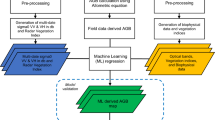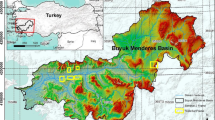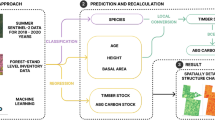Abstract
Understanding the spatial distribution of forest properties can help improve our knowledge of carbon storage and the impacts of climate change. Despite the active use of remote sensing and machine learning (ML) methods in forest mapping, the associated uncertainty predictions are relatively uncommon. The objectives of this study were: (1) to evaluate the spatial resolution effect on growing stock volume (GSV) mapping using Sentinel-2A and Landsat 8 satellite images, (2) to identify the most key predictors, and (3) to quantify the uncertainty of GSV predictions. The study was conducted in heterogeneous landscapes, covering anthropogenic areas, logging, young plantings and mature trees. We employed an ML approach and evaluated our models by root mean squared error (RMSE) and coefficient of determination (R2) through a 10-fold cross-validation. Our results indicated that the Sentinel-2A provided the best prediction performances (RMSE = 56.6 m3/ha, R2 = 0.53) in compare with Landsat 8 (RMSE = 71.2 m3/ha, R2 = 0.23), where NDVI, LSWI and B08 band (near-infrared spectrum) were identified as key variables, with the highest contribution to the model. Moreover, the uncertainty of GSV predictions using the Sentinel-2A was much smaller compared with Landsat 8. The combined assessment of accuracy and uncertainty reinforces the suitability of Sentinel-2A for applications in heterogeneous landscapes. The higher accuracy and lower uncertainty observed with the Sentinel-2A underscores its effectiveness in providing more reliable and precise information for decision-makers. This research is important for further digital mapping endeavours with accompanying uncertainty, as uncertainty assessment plays a pivotal role in decision-making processes related to spatial assessment and forest management.





Similar content being viewed by others
Data availability
No datasets were generated or analysed during the current study.
References
Ahmadi K, Kalantar B, Saeidi V, Harandi EKG, Janizadeh S, Ueda N (2020) Comparison of machine learning methods for mapping the stand characteristics of temperate forests using multi-spectral Sentinel-2 data. Remote Sens 12(18):3019. https://doi.org/10.3390/rs12183019
Anuchin NP (1982) Forest Taxation; Forestry Industry: Moscow, Russia, p. 551
Araza A, de Bruin S, Herold M, Quegan S, Labriere N, Rodriguez-Veiga P, Avitabile V, Santoro M, Mitchard ETA, Ryan CM, Phillips OL, Willcock S, Verbeeck H, Carreiras J, Hein L, Schelhaas M-J, Pacheco-Pascagaza AM, da Conceição Bispo P, Laurin GV, Vieilledent G, Slik F, Wijaya A, Lewis SL, Morel A, Liang J, Sukhdeo H, Schepaschenko D, Cavlovic J, Gilani H, Lucas R (2022) A comprehensive framework for assessing the accuracy and uncertainty of global above-ground biomass maps. Remote Sens Environ 272:112917. https://doi.org/10.1016/j.rse.2022.112917
Astola H, Häme T, Sirro L, Molinier M, Kilpi J (2019) Comparison of Sentinel-2 and Landsat 8 imagery for forest variable prediction in boreal region. Remote Sens Environ 223:257–273. https://doi.org/10.1016/j.rse.2019.01.019
Beck HE, Zimmermann NE, McVicar TR, Vergopolan N, Berg A, Wood EF (2018) Present and future Köppen-Geiger climate classification maps at 1-km resolution. Sci Data 5(1):180214. https://doi.org/10.1038/sdata.2018.214
Breiman L (2001) Random forests. Mach Learn 45(1):5–32. https://doi.org/10.1023/A:1010933404324
Burgheimer J, Wilske B, Maseyk K, Karnieli A, Zaady E, Yakir D, Kesselmeier J (2006) Relationships between Normalized Difference Vegetation Index (NDVI) and carbon fluxes of biologic soil crusts assessed by ground measurements. J Arid Environ 64(4):651–669. https://doi.org/10.1016/j.jaridenv.2005.06.025
Caffaratti GD, Marchetta MG, Euillades LD, Euillades PA, Forradellas RQ (2021) Improving forest detection with machine learning in remote sensing data. Remote Sens Applications: Soc Environ 24:100654. https://doi.org/10.1016/j.rsase.2021.100654
Chavez PS (1988) An improved dark-object subtraction technique for atmospheric scattering correction of multispectral data. Remote Sens Environ 24(3):459–479. https://doi.org/10.1016/0034-4257(88)90019-3
Chen G, Ozelkan E, Singh KK, Zhou J, Brown MR, Meentemeyer RK (2017) Uncertainties in mapping forest carbon in urban ecosystems. J Environ Manage 187:229–238. https://doi.org/10.1016/j.jenvman.2016.11.062
Cho N, Agossou C, Kim E, Lim J-H, Seo J-W, Kang S (2023) Machine-learning modeling on tree mortality and growth reduction of temperate forests with climatic and ecophysiological parameters. Ecol Model 483:110456. https://doi.org/10.1016/j.ecolmodel.2023.110456
Chrysafis I, Mallinis G, Siachalou S, Patias P (2017) Assessing the relationships between growing stock volume and Sentinel-2 imagery in a Mediterranean forest ecosystem. Remote Sens Lett 8(6):508–517. https://doi.org/10.1080/2150704X.2017.1295479
Clark ML (2020) Comparison of multi-seasonal landsat 8, Sentinel-2 and hyperspectral images for mapping forest alliances in Northern California. ISPRS J Photogrammetry Remote Sens 159:26–40. https://doi.org/10.1016/j.isprsjprs.2019.11.007
Engler R, Waser LT, Zimmermann NE, Schaub M, Berdos S, Ginzler C, Psomas A (2013) Combining ensemble modeling and remote sensing for mapping individual tree species at high spatial resolution. For Ecol Manag 310:64–73. https://doi.org/10.1016/j.foreco.2013.07.059
Gonzalez P, Asner GP, Battles JJ, Lefsky MA, Waring KM, Palace M (2010) Forest carbon densities and uncertainties from Lidar, QuickBird, and field measurements in California. Remote Sens Environ 114(7):1561–1575. https://doi.org/10.1016/j.rse.2010.02.011
Grabska E, Frantz D, Ostapowicz K (2020) Evaluation of machine learning algorithms for forest stand species mapping using Sentinel-2 imagery and environmental data in the Polish carpathians. Remote Sens Environ 251:112103. https://doi.org/10.1016/j.rse.2020.112103
Gu H, Townsend PA (2017) Mapping forest structure and uncertainty in an urban area using leaf-off lidar data. Urban Ecosyst 20(2):497–509. https://doi.org/10.1007/s11252-016-0610-9
Holdaway RJ, McNeill SJ, Mason NWH, Carswell FE (2014) Propagating uncertainty in plot-based Estimates of Forest Carbon Stock and Carbon Stock Change. Ecosystems 17(4):627–640. https://doi.org/10.1007/s10021-014-9749-5
Hu T, Su Y, Xue B, Liu J, Zhao X, Fang J, Guo Q (2016) Mapping Global Forest Aboveground Biomass with Spaceborne LiDAR, Optical Imagery, and Forest Inventory Data. Remote Sens 8(7):565. https://doi.org/10.3390/rs8070565
Huang S, Tang L, Hupy JP, Wang Y, Shao G (2021) A commentary review on the use of normalized difference vegetation index (NDVI) in the era of popular remote sensing. J Res 32(1):1–6. https://doi.org/10.1007/s11676-020-01155-1
Jiang F, Kutia M, Sarkissian AJ, Lin H, Long J, Sun H, Wang G (2020) Estimating the growing stem volume of coniferous plantations based on Random Forest using an optimized variable selection method. Sensors 20(24):7248. https://doi.org/10.3390/s20247248
Kangas A, Korhonen KT, Packalen T, Vauhkonen J (2018) Sources and types of uncertainties in the information on forest-related ecosystem services. For Ecol Manag 427:7–16. https://doi.org/10.1016/j.foreco.2018.05.056
Korhonen L, Hadi, Packalen P, Rautiainen M (2017) Comparison of Sentinel-2 and Landsat 8 in the estimation of boreal forest canopy cover and leaf area index. Remote Sens Environ 195:259–274. https://doi.org/10.1016/j.rse.2017.03.021
Li L, Zhou X, Chen L, Chen L, Zhang Y, Liu Y (2020) Estimating Urban Vegetation Biomass from Sentinel-2A Image Data. Forests 11:125. https://doi.org/10.3390/f11020125
Liu B, Gao L, Li B, Marcos-Martinez R, Bryan BA (2020) Nonparametric machine learning for mapping forest cover and exploring influential factors. Landsc Ecol 35(7):1683–1699. https://doi.org/10.1007/s10980-020-01046-0
Maier C, Hebermehl W, Grossmann CM, Loft L, Mann C, Hernández-Morcillo M (2021) Innovations for securing forest ecosystem service provision in Europe – A systematic literature review. Ecosyst Serv 52:101374. https://doi.org/10.1016/j.ecoser.2021.101374
Mauya EW, Koskinen J, Tegel K, Hämäläinen J, Kauranne T, Käyhkö N (2019) Modelling and Predicting the growing stock volume in small-Scale Plantation forests of Tanzania using Multi-sensor Image Synergy. Forests 10(3):279. https://doi.org/10.3390/f10030279
McRoberts RE, Tomppo EO (2007) Remote sensing support for national forest inventories. Remote Sens Environ 110(4):412–419. https://doi.org/10.1016/j.rse.2006.09.034
Meinshausen N (2006) Quantile regression forests. J Mach Learn Res 7(35):983–999
Mura M, Bottalico F, Giannetti F, Bertani R, Giannini R, Mancini M, Orlandini S, Travaglini D, Chirici G (2018) Exploiting the capabilities of the Sentinel-2 multi spectral instrument for predicting growing stock volume in forest ecosystems. Int J Appl Earth Obs Geoinf 66:126–134. https://doi.org/10.1016/j.jag.2017.11.013
Nasiri V, Darvishsefat AA, Arefi H, Griess VC, Sadeghi SMM, Borz SA (2022) Modeling Forest Canopy Cover: a synergistic use of Sentinel-2, Aerial Photogrammetry Data, and machine learning. Remote Sens 14(6):1453. https://doi.org/10.3390/rs14061453
Persson HJ, Ståhl G (2020) Characterizing uncertainty in Forest Remote Sensing studies. Remote Sens 12(3):505. https://doi.org/10.3390/rs12030505
Pettorelli N, Ryan S, Mueller T, Bunnefeld N, Jędrzejewska B, Lima M, Kausrud K (2011) The normalized difference Vegetation Index (NDVI): unforeseen successes in animal ecology. Climate Res 46(1):15–27. https://doi.org/10.3354/cr00936
Richardson JJ, Moskal LM (2014) Uncertainty in urban forest canopy assessment: lessons from Seattle, WA, USA. Urban forestry. Urban Green 13(1):152–157. https://doi.org/10.1016/j.ufug.2013.07.003
Rouse JW, Haas RH, Schell JA, Deering DW (1974) Monitoring vegetation systems in the Great Plains with ERTS. NASA. Goddard Space Flight Center 3d ERTS-1 Symp., Vol. 1, Sect. A. https://ntrs.nasa.gov/citations/19740022614
Sesnie SE, Espinosa CI, Jara-Guerrero AK, Tapia-Armijos MF (2023) Ensemble Machine Learning for Mapping Tree Species Alpha-Diversity using Multi-source Satellite Data in an Ecuadorian seasonally Dry Forest. Remote Sens 15(3):583. https://doi.org/10.3390/rs15030583
Shrestha DL, Solomatine DP (2006) Machine learning approaches for estimation of prediction interval for the model output. Neural Netw 19(2):225–235. https://doi.org/10.1016/j.neunet.2006.01.012
Singh D, Herlin I, Berroir JP, Silva EF, Simoes Meirelles M (2004) An approach to correlate NDVI with soil colour for erosion process using NOAA/AVHRR data. Adv Space Res 33(3):328–332. https://doi.org/10.1016/S0273-1177(03)00468-X
Singh S, Sood V, Taloor AK, Prashar S, Kaur R (2021) Qualitative and quantitative analysis of topographically derived CVA algorithms using MODIS and Landsat-8 data over Western Himalayas, India. Quatern Int 575–576:85–95. https://doi.org/10.1016/j.quaint.2020.04.048
Suleymanov R, Yaparov I, Saifullin I, Vildanov I, Shirokikh P, Suleymanov A, Komissarov M (2020) The current state of abandoned lands in the northern forest-steppe zone at the Republic of Bashkortostan (Southern Ural, Russia). Span J Soil Sci 10:33–35. https://doi.org/10.3232/SJSS.2020.V10.N1.03
Suleymanov A, Bogdan E, Gaysin I, Volkov A, Tuktarova I, Belan L, Shagaliev R (2024) Spatial high-resolution modelling and uncertainty assessment of forest growing stock volume based on remote sensing and environmental covariates. For Ecol Manag 554:121676. https://doi.org/10.1016/j.foreco.2023.121676
Tian L, Wu X, Tao Y, Li M, Qian C, Liao L, Fu W (2023) Review of remote sensing-based methods for forest Aboveground Biomass Estimation: Progress, challenges, and prospects. Forests 14(6):1086. https://doi.org/10.3390/f14061086
Tigges J, Lakes T (2017) High resolution remote sensing for reducing uncertainties in urban forest carbon offset life cycle assessments. Carbon Balance Manag 12(1):17. https://doi.org/10.1186/s13021-017-0085-x
Tripathi A, Tiwari RK (2022) Synergetic utilization of sentinel-1 SAR and sentinel-2 optical remote sensing data for surface soil moisture estimation for Rupnagar, Punjab, India. Geocarto Int 37(8):2215–2236. https://doi.org/10.1080/10106049.2020.1815865
Tsuchikawa S, Ma T, Inagaki T (2022) Application of near-infrared spectroscopy to agriculture and forestry. ANAL SCI 38(4):635–642. https://doi.org/10.1007/s44211-022-00106-6
Tucker CJ (1979) Red and photographic infrared linear combinations for monitoring vegetation. Remote Sens Environ 8(2):127–150. https://doi.org/10.1016/0034-4257(79)90013-0
Uniyal S, Purohit S, Chaurasia K, Rao SS, Amminedu E (2022) Quantification of carbon sequestration by urban forest using landsat 8 OLI and machine learning algorithms in Jodhpur, India. Urban Forestry Urban Green 67:127445. https://doi.org/10.1016/j.ufug.2021.127445
Volkov A, Belan L, Bogdan E, Suleymanov A, Tuktarova I, Shagaliev R, Muftakhina D (2023) Spatio-temporal analysis of forest growing stock volume and Carbon stocks: a case study of Kandry-Kul Natural Park, Russia. Land 12(7):1441. https://doi.org/10.3390/land12071441
Wang Z, Gong H, Huang M, Gu F, Wei J, Guo Q, Song W (2023) A multimodel random forest ensemble method for an improved assessment of Chinese terrestrial vegetation carbon density. Methods Ecol Evol 14(1):117–132. https://doi.org/10.1111/2041-210X.13729
Xiao X, Zhang Q, Braswell B, Urbanski S, Boles S, Wofsy S, Moore B, Ojima D (2004) Modeling gross primary production of temperate deciduous broadleaf forest using satellite images and climate data. Remote Sens Environ 91(2):256–270. https://doi.org/10.1016/j.rse.2004.03.010
Xie Y, Sha Z, Yu M (2008) Remote sensing imagery in vegetation mapping: a review. J Plant Ecol 1(1):9–23. https://doi.org/10.1093/jpe/rtm005
Xu K, Zhang Z, Yu W, Zhao P, Yue J, Deng Y, Geng J (2021) How spatial resolution affects forest phenology and tree-species classification based on Satellite and Up-Scaled time-series images. Remote Sens 13(14):2716. https://doi.org/10.3390/rs13142716
Zharko VO, Bartalev SA, Sidorenkov VM (2020) Forest growing stock volume estimation using optical remote sensing over snow-covered ground: a case study for Sentinel-2 data and the Russian Southern Taiga region. Remote Sens Lett 11(7):677–686. https://doi.org/10.1080/2150704X.2020.1755473
Zhou Y, Feng Z (2023) Estimation of Forest Stock volume using Sentinel-2 MSI, Landsat 8 OLI Imagery and Forest Inventory Data. Forests 14(7):1345. https://doi.org/10.3390/f14071345
Funding
This study was funded by the Ministry of Science and Higher Education of the Russian Federation “PRIORITY 2030” (National Project “Science and University”).
Author information
Authors and Affiliations
Contributions
Azamat Suleymanov: conceptualization, methodology, software, validation, visualization, roles/writing —original draft; Ruslan Shagaliev: supervision, methodology, data curation, writing—review and editing; Larisa Belan: data collection and formal analysis, roles/writing —review and editing; Ekaterina Bogdan: data collection and formal analysis, roles/writing —review and editing; Iren Tuktarova: data collection and formal analysis, roles/writing —review and editing; Eduard Nagaev: data collection and formal analysis, roles/writing —review and editing; Dilara Muftakhina: data collection and formal analysis, visualization, roles/writing —review and editing. All authors reviewed the manuscript.
Corresponding author
Ethics declarations
Ethical approval
Not applicable. All authors have read, understood, and have complied as applicable with the statement on “Ethical responsibilities of Authors” as found in the Instructions for Authors.
Consent to participate
Informed consent was obtained from all individual participants included in the study.
Competing interests
The authors declare no competing interests.
Additional information
Communicated by Hassan Babaie.
Publisher’s note
Springer Nature remains neutral with regard to jurisdictional claims in published maps and institutional affiliations.
Rights and permissions
Springer Nature or its licensor (e.g. a society or other partner) holds exclusive rights to this article under a publishing agreement with the author(s) or other rightsholder(s); author self-archiving of the accepted manuscript version of this article is solely governed by the terms of such publishing agreement and applicable law.
About this article
Cite this article
Suleymanov, A., Shagaliev, R., Belan, L. et al. Forest growing stock volume mapping with accompanying uncertainty in heterogeneous landscapes using remote sensing data. Earth Sci Inform 17, 5359–5369 (2024). https://doi.org/10.1007/s12145-024-01457-6
Received:
Accepted:
Published:
Issue Date:
DOI: https://doi.org/10.1007/s12145-024-01457-6




